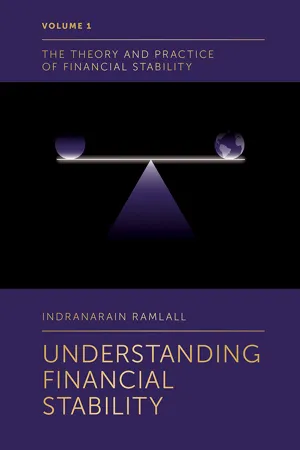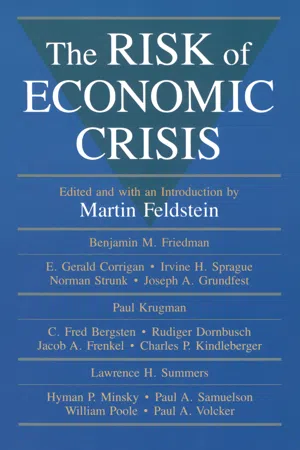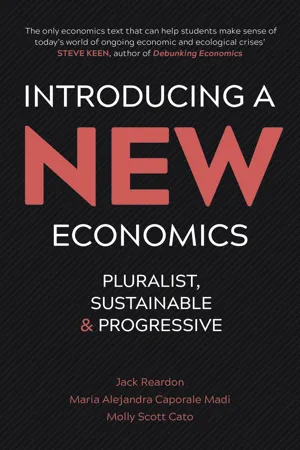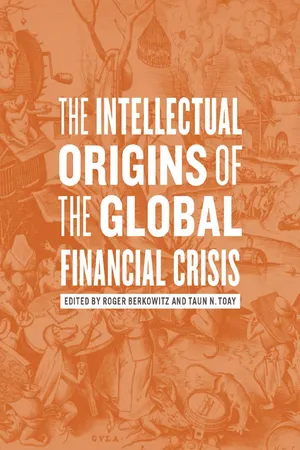Economics
Financial Crisis
A financial crisis refers to a period of severe disruption in the financial markets, often characterized by a sharp decline in asset prices and a lack of liquidity in the financial system. These crises can have widespread and profound effects on the economy, leading to bank failures, credit crunches, and economic recessions.
Written by Perlego with AI-assistance
Related key terms
Related key terms
1 of 4
Related key terms
1 of 3
8 Key excerpts on "Financial Crisis"
- eBook - ePub
Feminist Political Economy
A Global Perspective
- Sara Cantillon, Odile Mackett, Sara Stevano(Authors)
- 2023(Publication Date)
- Agenda Publishing(Publisher)
The last section focuses on the Covid-19 pandemic and the economic crisis that emerged from the health crisis. 10.2 Definitions of an economic crisis The term “crisis” implies a deviation from some degree of normality. Crises range from wars, financial market crashes and health crises to natural disasters. Often crises have important economic impacts on the communities that are affected by them. Consequently, they tend to result in some form of reorganization in the way resources are obtained, distributed and accumulated. A historical analysis of resource distribution and accumulation often provides important clues as to how communities, individuals and countries fare during and in the aftermath of a crisis, and some even result in a change (even if small) in prevailing gender norms. A crisis need not be widespread, and, when a crisis does hit, some groups may be better prepared for it than others. Nevertheless, it becomes useful to define a crisis, for whom the crisis exists and the scale thereof. A debtor, whether it be a household, firm, or country, “experiences a Financial Crisis when it cannot meet current debt obligations and its creditors demand repayment” (Floro & Dymski 2000 : 1271). A Financial Crisis implies that some degree of scarcity in relation to monetary resources arises, and a country faces a Financial Crisis when it is unable to meet its debt obligations. Financial crises are closely linked to the concept of financialization, which is defined by Isaacs (2016 : 8) as “the predominance of the influence of financial markets over more and more spheres of economic, political and social life and the subjugation of these to the logic, dictates and imperatives of financial markets”. However, monetary resources are not the only necessary resources in an economy, and the economics discipline has an interest in exploring the distribution of a broader range of resources, such as natural resources, human and environmental well-being and time - eBook - ePub
- Indranarain Ramlall(Author)
- 2018(Publication Date)
- Emerald Publishing Limited(Publisher)
Chapter 6
Financial Crises
6.1. Key Features of A Crisis
- Economic and financial crises tend to be recurrent in nature. This implies that the same phenomena are at work to constitute the genesis of a crisis.
- Nearly, all crises exhibit three common elements. First, there is distrust in the financial system or lack of confidence in the financial system. Second, there are spillover or contagion effects such as in the case of Allen and Gale (2009) who base themselves on the contagious transmission of bank difficulties. Third, there are network effects based on endogenous interactions among different financial institutions.
- A crisis is usually financial in first stage to then entangle the real economy in the second stage. This can be corroborated by the evolution of the global Financial Crisis in 2007 into an economic crisis and thereafter into a debt crisis.
- Crisis often occurs because market players assume that EMH (all relevant information is automatically reflected in the price) holds while in practice it is hard to see that assets are properly priced – a clear instance of this appears during the US subprime crisis.
- Humans have a strong tendency to herd so that deleveraging of assets often witnesses a highly painful adjustment in the financial system, all geared towards an unending downward spiral in asset prices.
- Crises are often caused by two events, a euphoria phase and a de-illusion stage. Under the euphoria stage, there are strong incentives to push forward asset prices while in the de-illusion stage, investors began to realise of over-valued assets which then lead to massive sell-offs and drastic asset price declines. The leverage cycle (Geneakopolous, 2009) contributes to higher asset prices. When the de-illusion stage manifested in the case of the US subprime crisis, it led to negative equity holdings by borrowers who had no choice but to deliberately default on their home loans.
- Political forces can also contribute to crises. For instance, in the case of the US subprime crisis, there were strong political incentives to make each household own his home.
- eBook - ePub
- Martin Feldstein, Martin Feldstein(Authors)
- 2009(Publication Date)
- University of Chicago Press(Publisher)
Section 3.3 asks how a Financial Crisis could affect the real economy in the presence of a sufficiently aggressive lender of last resort. This would be most likely if the provision of liquidity was itself destabilizing. Suppose foreigners lose confidence and rush to get out of dollar assets in U.S. financial institutions. Such a situation would be difficult for the authorities because the actions necessary to preserve the health of financial institutions would conflict with the goal of preventing a currency collapse. Conversely, the high interest rates necessary to avert a collapsing currency would tend to create financial distress.Section 3.4 concludes by assessing the magnitude of the crisis risk and by suggesting steps that might make Financial Crisis less likely.3.1 The Canonical CrisisPerhaps the best definition of a Financial Crisis is the one offered by Goldsmith (1982) in commenting on Minsky (1982). He defines a Financial Crisis as “a sharp, brief, ultra-cyclical deterioration of all or most of a group of financial indicators—short term interest rates, asset prices, (stock, real estate, land) prices, commercial insolvencies and failures of financial institutions.” On this definition, even very sharp declines in asset values such as the two-thirds decline in U.S. real stock prices between the beginning of 1973 and summer of 1974 does not represent a Financial Crisis. Nor do widespread financial institution failures such as the S&L crisis unless they occur suddenly and lead to widespread failures of financial institutions.On a narrow definition, the incidence of Financial Crisis has surely diminished over time. After noting that “a disinflation or a deflation may be long drawn out. Nominal wealth may decline, real debts may rise, but these are not Financial Crisis,” Anna Schwartz (1986) goes so far as to claim that “no Financial Crisis has occurred in the United States since 1933, and none has occurred in the United Kingdom since 1866. All the phenomena of recent years that have been characterised as Financial Crisis—a decline in asset prices of equity stocks, real estate, commodities; depreciation of the exchange value of a national currency; financial distress of a large nonfinancial firm, a large municipality, a financial industry, or sovereign debtors—are pseudo-Financial Crisis.” - eBook - ePub
History and Financial Crisis
Lessons from the 20th century
- Christopher Kobrak, Mira Wilkins(Authors)
- 2014(Publication Date)
- Routledge(Publisher)
Kindleberger used the term ‘financial crises’ in the subtitle of his classic Manias, panics, and crashes. But he recognised that there was a fundamental issue about the relationship between ‘financial’ and ‘economic’ crises. Although financial breakdowns may arise when other markets weaken – labour or housing, for example – or when the prices of securities lose any kind of meaningful relationship with the real assets they represent, the term ‘economic crisis’ has tended to be more associated with severe drops in indicators such as employment and Gross Domestic Product, which may themselves be spill-over effects from financial or other events. Kindleberger was clearly not interested in cyclical economic downturns, but he knew that ‘turbulent financial prices’ evolved into crises as they threatened broader economic indicators. For him the terms ‘financial and economic crises’ were separate but intertwined. Like our own crisis, so many previous ones began with a downturn in some asset class or some broad based economic indictors, which in turn affected others and then seemed to spiral out of control. In the first edition of his volume on Manias, panics, and crashes, published in 1978, Kindleberger was very specific on his subject matter, emphasising the linkage between ‘financial and economic crisis’: Financial crises are associated with the peaks of business cycles. We are not interested in the business cycle as such, the rhythm of economic expansion and contraction, but only in the Financial Crisis that is the culmination of a period of expansion and leads to the downturn. If there be business cycles without financial crises, they lie out of our interest. On the other hand, financial crises that prove so manageable as to have no effects on the economic system will also be neglected. The Financial Crisis we shall consider here are major both in size and in effect and, as a rule, international in scope. (Kindleberger, 1978, p - eBook - ePub
The Bank Credit Analysis Handbook
A Guide for Analysts, Bankers and Investors
- Jonathan Golin, Philippe Delhaise(Authors)
- 2013(Publication Date)
- Wiley(Publisher)
There are archetypal scenarios but no uniform pattern. The three scenarios enumerated below are among the most common.1. Early and sharp decline. The shift to the crisis may occur quickly in a dramatic fashion, as some event presents an enormous shock to the market—the failure of a major bank, for example.2. After a period of uncertainty that prevails for several weeks or months, a panic arises, and prices fall precipitously.3. The contraction phase sets in gradually without a period of panic and an accompanying plunge in prices; problems in the banking industry surface gradually as the recession grows deeper.As scenario three illustrates, a banking crisis need not coincide with a precipitous fall in asset prices, such as a stock market crash. It is, however, not unusual for a banking crisis to begin with such a period of panic (as scenarios one and two illustrate) that may last for days or weeks, during which key financial markets are characterized by either a steep plunge in prices or an equally sharp widening of spreads. When markets experience such sharp corrections, the onset of the crisis is clearly marked.Nevertheless, such an event is not a mandatory prelude to a serious banking crisis. When the banking system reaches a threshold level of vulnerability—and the crisis of 2007–2012 demonstrated that banks are vulnerable to many more factors than the traditional bubbles, for example to liquidity issues—a crisis could conceivably surface at any time during the phase of economic contraction. In the same manner, absent such vulnerability, a banking crisis is not inevitable as the business cycle turns after a prolonged expansionary phase. This said, banking is a cyclical industry, and member institutions face much tougher times when the economy is contracting than they do during a period of rising prosperity.The strong returns of the peak boom period weaken during the transition period.88 Less vigorous price rises dampen expectations resulting in flattening or declining loan growth. This is accompanied by higher NPLs and NPL ratios as the expanding denominator no longer can mask growth in the percentage of duff loans. At the same time, rising NPLs will compel the bank to set aside higher levels of loan-loss provisioning to compensate for the decline in asset quality arising from growth in delinquencies. That is, as the bank’s credit costs outpace growth in its operating income, such costs will consume an increasing chunk of pretax income.89 - eBook - ePub
Introducing a New Economics
Pluralist, Sustainable and Progressive
- Jack Reardon, Maria Alejandra Caporale Madi, Molly Scott Cato(Authors)
- 2017(Publication Date)
- Pluto Press(Publisher)
14
Recessions and Financial Crises
All economies go through cycles of boom and bust, otherwise known as ‘the business cycle’. This chapter will investigate whether the business cycle is inevitable or is a consequence of how the economy is structured. Are there institutional adjustments that can prevent or ameliorate it? We will first define the business cycle, then discuss how recessions are defined and measured. We then ask about the causes and origins of financial crises – a specific type of recession that most of us are now familiar with. We will then look to the global picture and ask: What is the proper role of global financial architecture? And what are alternative economic policies for sustainable economic growth?14.1 SETTING THE SCENE: WHAT IS A BUSINESS CYCLE?
A business cycle refers to the ups (expansions) and downs (recessions) of the economy. Perhaps the term ‘business cycle’ is misleading, since it affects everyone rather than just businesses; and the word ‘cycle’ implies circularity; that what goes around comes around. But no two business cycles are alike: they differ in terms of severity, causation and length. Likewise, no two recessions are alike, for they differ in length and severity; and no two expansions are alike, also differing in length and vigour.A business cycle is a short-term phenomenon, to be distinguished from long-term economic swings. Throughout the business cycle there are alternating increases and decreases in the level of economic activity, of varying amplitude and length. A conventional business cycle contains the following phases:• a beginning or recovery • an expansion phase, in which the economy grows • a peak, at which the expansion reaches a relative maximum • a contraction (recession), in which the level of economic activity declines • a trough, in which the economy reaches a relative low point. After the trough, the economy recovers, and we begin the next cycle. - Roger Berkowitz, Taun N. Toay, Roger Berkowitz, Taun N. Toay(Authors)
- 2012(Publication Date)
- Fordham University Press(Publisher)
PART III The Crisis of EconomicsPassage contains an image TEN The Roots of the Crisis :: SANJAY G. REDDY
Practical men, who believe themselves to be quite exempt from any intellectual influences, are usually the slaves of some defunct economist. Madmen in authority, who hear voices in the air, are distilling their frenzy from some academic scribbler of a few years back. I am sure that the power of vested interests is vastly exaggerated compared with the gradual encroachment of ideas. Not, indeed, immediately, but after a certain interval; for in the field of economic and political philosophy there are not many who are influenced by new theories after they are twenty-five or thirty years of age, so that the ideas which civil servants and politicians and even agitators apply to current events are not likely to be the newest. But, soon or late, it is ideas, not vested interests, which are dangerous for good or evil.—JOHN MAYNARD KEYNES, THE GENERAL THEORY OF EMPLOYMENT, INTEREST AND MONEYThe Financial Crisis itself has made it possible to have a new kind of conversation across the trenches of disciplines—the kind that is taking place in this volume. I do not think it would have been possible to have this sort of conversation five or ten years ago. There is a sense of shock that accompanies an unexpected event of this magnitude, and a searching for answers. This has rightly undermined previous disciplinary prerogatives and created a more welcoming atmosphere for new approaches.Academics in various disciplines, as well as ordinary citizens, quite legitimately want to know what exactly happened, and how it is going to affect their futures. We have a new level of interest in economic questions and some skepticism about the previous answers provided. Economists in particular have been scrambling to provide answers, often in a rather ex-post- Pascal Bridel, Muriel Dalpont(Authors)
- 2017(Publication Date)
- Routledge(Publisher)
Economics of the crisis and the crisis of economics Axel Leijonhufvud1. Balance sheet troubles
This is not an ordinary recession. The problems unleashed by the Financial Crisis are far more serious and intractable than that.The United States and the Eurozone countries are in the midst of a balance sheet recession. The concept is due to Richard Koo1 who used the term to summarise his diagnosis of Japan’s economic troubles in the wake of its 1992–1993 crisis. A balance sheet recession is fundamentally different from the garden variety and the usual countercyclical policies are not adequate to cope with it. The questions to be discussed below all pertain to the extraordinary nature of balance sheet recessions in general and, of course, the present one in particular: What makes them different from ordinary cyclical recessions? How do they come about? What makes them peculiarly intractable? What policies are effective or less effective in dealing with them?Apart from these substantive questions, there is one further question worth considering: What kind of economic theory helps us understand these matters better and what kinds do not?2. Stability and instability
How did we end up in our present unpredicted predicament? A short answer would be: by not being alert to the symptoms of instability. Almost all bankers, regulators, policy-makers and (of course) economists disregarded the possibility of serious systemic instability. But the widespread assumption that a system of “free markets” is stable needs re-examination.2.1 Markets for produced goods
The beginning student’s first introduction to economics tends to be the supply and demand model for a produced good. Two negative feedback loops are supposed to guarantee that the equilibrium is reached (ceteris paribus). If supply exceeds demand, price will rise so as to reduce the discrepancy in quantities. If marginal cost exceeds the demand price, output will decline so as to decrease the discrepancy in values. Both feedbacks reduce the deviation
Index pages curate the most relevant extracts from our library of academic textbooks. They’ve been created using an in-house natural language model (NLM), each adding context and meaning to key research topics.
Explore more topic indexes
Explore more topic indexes
1 of 6
Explore more topic indexes
1 of 4







